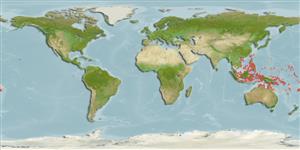Common names from other countries
Environment: milieu / climate zone / ระดับความลึก / distribution range
นิเวศวิทยา
เกี่ยวกับทะเล,น้ำเค็ม; น้ำจืด; กร่อย สัตว์น้ำหน้าดิน; สัตว์น้ำที่อพยพไปๆมาๆ ระหว่างแหล่งน้ำจืดกับทะเล ที่เป็นไปตามช่วงชีวิต (Ref. 51243). Tropical; 29°N - 20°S
Asia and Oceania: Ryukyu Islands in Japan, Taiwan, Philippines, Indonesia, Solomon Islands, New Guinea and northern Australia. Reported from Palau (Ref. 6371), Fiji (Ref. 12743) New Caledonia (Ref. 13235) and Vanuatu (Ref. 97791).
ขนาด / น้ำหนัก / Age
วัยเจริญพันธุ์: Lm ? range ? - ? cm
Max length : 14.0 cm SL เพศผู้/กระเทย; (Ref. 7050)
เงี่ยงครีบหลัง (รวม) : 7; ก้านครีบอ่อนที่หาง (รวม) : 9; เงี่ยงครีบก้น: 1; ก้านครีบอ่อนที่ก้น: 8. Distinguished by the following characters: mouth moderate; reaching to a point below anterior margin to middle of eye; operculum with a small patch of 10-20 scales dorsally in 2-3 longitudinal rows; second dorsal rays I,8; pectoral rays 18-21 (usually 19 or 20); predorsal scale count 15-19; one or usually two small lateral canal head pores above anterior operculum just before terminal lateral canal pore; papilla line 6 well developed; papilla lines composed of a single row of papillae; snout length 11.6-13.6% SL ; body with 5 oval, horizontally elongate brown to black spots on midside from second dorsal origin to posterior end of caudal peduncle; spots usually bordered by faint brown lines above and below.
Body shape (shape guide): fusiform / normal.
Adults live in clear streams, usually close to the sea (Ref. 5259). They occur mainly in fresh water, but larvae in marine environment (Ref. 5259).
Life cycle and mating behavior
วัยเจริญพันธุ์ | การสืบพันธุ์ | การวางไข่ | เซลสืบพันธ์ของเพศเมีย(ไข่) | ความดกของไข่ | ตัวอ่อน
Allen, G.R., 1991. Field guide to the freshwater fishes of New Guinea. Publication, no. 9. 268 p. Christensen Research Institute, Madang, Papua New Guinea. (Ref. 2847)
IUCN Red List Status (Ref. 130435: Version 2025-1)
Threat to humans
Harmless
Human uses
การประมง: มีการค้าเพียงเล็กน้อย
เครื่องมือ
Special reports
Download XML
แหล่งที่มาจากอินเตอร์เน็ต
Estimates based on models
Preferred temperature (อ้างอิง
123201): 27.1 - 29.3, mean 28.7 °C (based on 1441 cells).
Phylogenetic diversity index (อ้างอิง
82804): PD
50 = 0.5000 [Uniqueness, from 0.5 = low to 2.0 = high].
Bayesian length-weight: a=0.01023 (0.00477 - 0.02194), b=3.01 (2.83 - 3.19), in cm total length, based on LWR estimates for this (Sub)family-body shape (Ref.
93245).
ระดับชั้นอาหาร (อ้างอิง
69278): 3.3 ±0.42 se; based on food items.
ความสามารถในการกลับคืนสู่ปกติ (อ้างอิง
120179): ความสูง, เวลาต่ำสุดที่จะทำให้ประชากรเพิ่มขึ้นเป็น 2 เท่าใช้เวลาน้อยกว่า 15 เดือน (Preliminary K or Fecundity.).
Fishing Vulnerability (Ref.
59153): Low vulnerability (10 of 100).
🛈
